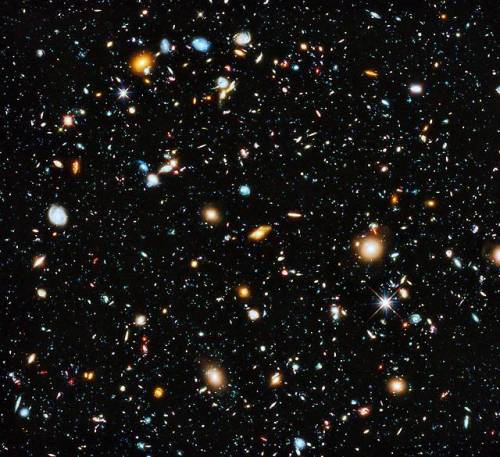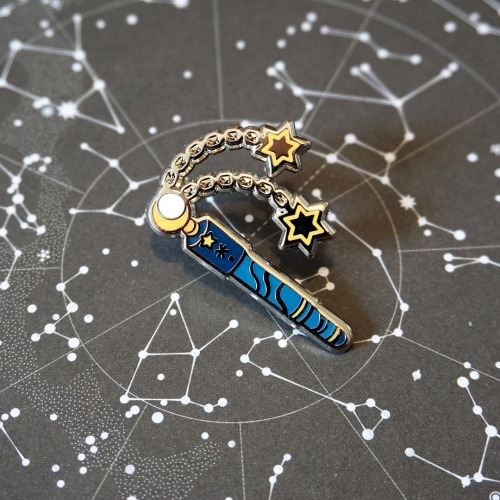NASA Ultra Deep Field 2014 - 10,000 Galaxies

NASA Ultra Deep Field 2014 - 10,000 Galaxies
In 2004, NASA pointed the Hubble into a very small section of space and the result was amazing…
More Posts from Space-cute and Others


Double exposure of the moon (over exposure + normal exposure) by cosmicgrey
★☆★ SPACE ★☆★

Astronomers long thought that a peculiar star system observed by the European Space Agency’s Gaia satellite was a simple case of a star orbiting a black hole.
But now, two astronomers are challenging that claim, finding that the evidence suggests something far stranger: Possibly, a never-before-seen type of star made of invisible dark matter. Their research, which has yet to be peer-reviewed, was published April 18 on the preprint server arXiv.
The system itself consists of a sunlike star and, well, something else. The star weighs a little less than the sun (0.93 solar mass) and has roughly the same chemical abundance as the sun. Its mysterious companion is much more massive — around 11 solar masses. The objects orbit each other at a distance of 1.4 astronomical units, about the distance at which Mars orbits the sun, making a complete orbit every 188 days.
Continue Reading

With NASA announcing their streaming service NASA+ and also announcing it’s going to be free and also ad free, I’d just like to appreciate the lengths they go to make scientific knowledge and exploration as available as they possibly can.










Stellar Armory Pins
Atelier Persephone on Etsy
𝐀𝐛𝐨𝐮𝐭 𝟏,𝟑𝟐𝟎 𝐥𝐢𝐠𝐡𝐭-𝐲𝐞𝐚𝐫𝐬 𝐚𝐰𝐚𝐲 𝐟𝐫𝐨𝐦 𝐰𝐡𝐞𝐫𝐞 𝐲𝐨𝐮'𝐫𝐞 𝐬𝐢𝐭𝐭𝐢𝐧𝐠 𝐢𝐬 𝐭𝐡𝐞 𝐩𝐫𝐞𝐭𝐭𝐲 𝐩𝐚𝐬𝐭𝐞𝐥 𝐩𝐥𝐚𝐧𝐞𝐭, 𝐓𝐎𝐈-𝟏𝟑𝟑𝟖 𝐛. 𝐀 𝐍𝐞𝐩𝐭𝐮𝐧𝐞-𝐥𝐢𝐤𝐞 𝐞𝐱𝐨𝐩𝐥𝐚𝐧𝐞𝐭 𝐭𝐡𝐚𝐭'𝐬 𝐚𝐥𝐦𝐨𝐬𝐭 𝐭𝐡𝐞 𝐬𝐢𝐳𝐞 𝐨𝐟 𝐒𝐚𝐭𝐮𝐫𝐧, 𝐚𝐧𝐝 𝐢𝐬 𝟔.𝟗 𝐭𝐢𝐦𝐞𝐬 𝐛𝐢𝐠𝐠𝐞𝐫 𝐭𝐡𝐞𝐧 𝐄𝐚𝐫𝐭𝐡. 𝐓𝐡𝐞 𝐩𝐥𝐚𝐧𝐞𝐭 𝐰𝐚𝐬 𝐟𝐨𝐮𝐧𝐝 𝐛𝐲 𝐖𝐨𝐥𝐟 𝐂𝐮𝐤𝐢𝐞𝐫, 𝐚 𝐡𝐢𝐠𝐡 𝐬𝐜𝐡𝐨𝐨𝐥 𝐬𝐭𝐮𝐝𝐞𝐧𝐭, 𝐰𝐡𝐨 𝐣𝐨𝐢𝐧𝐞𝐝 𝐭𝐡𝐞 𝐆𝐨𝐝𝐝𝐚𝐫𝐝 𝐒𝐩𝐚𝐜𝐞 𝐅𝐥𝐢𝐠𝐡𝐭 𝐂𝐞𝐧𝐭𝐞𝐫 𝐚𝐬 𝐚 𝐬𝐮𝐦𝐦𝐞𝐫 𝐢𝐧𝐭𝐞𝐫𝐧. 💫💗✨












Galaxy Animal Necklaces and T-Shirts
Sushi Studios on Etsy
See our #Etsy or #Galaxy tags

Cone Nebula

Friends of NASA originally shared:
Red Mars and Rising Moon
Credit: Joseph Brimacombe
Location: Savannah Skies Observatory, Chillagoe, Queensland, Australia
Image Date: August 1, 2018
Technical details:
a modified Canon 6D and 16-35-mm Lens in a Cyclapse protective housing
Australia
Google Australia
Queensland, Australia
Queensland University of Technology (QUT)
University of Southern Queensland - Australia
CSIRO science image
#Earth #Astronomy #Science #Space #Stars #Mars #RedPlanet #Opposition #Moon #SolarSystem #Astrophotography #Photography #SavannahSkies #Observatory #Queensland #Australia #Outback #STEM #Education
https://plus.google.com/+RanthoMorule/posts/hVeQnHQyKpj
-
 loveologism reblogged this · 5 months ago
loveologism reblogged this · 5 months ago -
 de-launaie liked this · 6 months ago
de-launaie liked this · 6 months ago -
 science-is-better reblogged this · 1 year ago
science-is-better reblogged this · 1 year ago -
 science-is-better liked this · 1 year ago
science-is-better liked this · 1 year ago -
 idreamofspring1 reblogged this · 2 years ago
idreamofspring1 reblogged this · 2 years ago -
 rosalysaoirse reblogged this · 2 years ago
rosalysaoirse reblogged this · 2 years ago -
 rosalysaoirse liked this · 2 years ago
rosalysaoirse liked this · 2 years ago -
 starfilled-heart reblogged this · 2 years ago
starfilled-heart reblogged this · 2 years ago -
 starfilled-heart liked this · 2 years ago
starfilled-heart liked this · 2 years ago -
 rowan-wald liked this · 4 years ago
rowan-wald liked this · 4 years ago -
 aziliyae-blog liked this · 4 years ago
aziliyae-blog liked this · 4 years ago -
 thomasbrisenio liked this · 4 years ago
thomasbrisenio liked this · 4 years ago -
 percyjacksonwriter liked this · 4 years ago
percyjacksonwriter liked this · 4 years ago -
 tiny-werebear liked this · 4 years ago
tiny-werebear liked this · 4 years ago -
 happyk44 reblogged this · 4 years ago
happyk44 reblogged this · 4 years ago -
 bloomaniac liked this · 4 years ago
bloomaniac liked this · 4 years ago -
 lord-owl reblogged this · 5 years ago
lord-owl reblogged this · 5 years ago -
 why-am-i-on-this-website-anyway liked this · 5 years ago
why-am-i-on-this-website-anyway liked this · 5 years ago -
 hirodrewsykes reblogged this · 5 years ago
hirodrewsykes reblogged this · 5 years ago -
 thespacebeyondtheuniverse liked this · 5 years ago
thespacebeyondtheuniverse liked this · 5 years ago -
 malefemcel reblogged this · 5 years ago
malefemcel reblogged this · 5 years ago -
 kclmcaskett reblogged this · 5 years ago
kclmcaskett reblogged this · 5 years ago -
 kclmcaskett liked this · 5 years ago
kclmcaskett liked this · 5 years ago -
 astraecus liked this · 5 years ago
astraecus liked this · 5 years ago -
 straworriez liked this · 5 years ago
straworriez liked this · 5 years ago -
 really-fucking-tired liked this · 5 years ago
really-fucking-tired liked this · 5 years ago -
 taoscout liked this · 5 years ago
taoscout liked this · 5 years ago -
 rachelmnop reblogged this · 5 years ago
rachelmnop reblogged this · 5 years ago -
 spetzerfehn liked this · 5 years ago
spetzerfehn liked this · 5 years ago -
 richieadomako reblogged this · 5 years ago
richieadomako reblogged this · 5 years ago -
 extraordinaryfeline reblogged this · 5 years ago
extraordinaryfeline reblogged this · 5 years ago -
 sailornnoon reblogged this · 5 years ago
sailornnoon reblogged this · 5 years ago -
 thestitcher liked this · 5 years ago
thestitcher liked this · 5 years ago -
 0oooooooooooooooooo0 reblogged this · 5 years ago
0oooooooooooooooooo0 reblogged this · 5 years ago -
 millennium-jim liked this · 5 years ago
millennium-jim liked this · 5 years ago -
 megacosms reblogged this · 5 years ago
megacosms reblogged this · 5 years ago -
 goldfincher reblogged this · 5 years ago
goldfincher reblogged this · 5 years ago -
 awillowwand reblogged this · 5 years ago
awillowwand reblogged this · 5 years ago -
 rainywithachanceofstars liked this · 5 years ago
rainywithachanceofstars liked this · 5 years ago -
 painstained reblogged this · 5 years ago
painstained reblogged this · 5 years ago -
 painstained liked this · 5 years ago
painstained liked this · 5 years ago -
 ibroketuesday reblogged this · 5 years ago
ibroketuesday reblogged this · 5 years ago -
 ancyd liked this · 5 years ago
ancyd liked this · 5 years ago -
 quasi-normalcy reblogged this · 5 years ago
quasi-normalcy reblogged this · 5 years ago -
 lxstinspace reblogged this · 5 years ago
lxstinspace reblogged this · 5 years ago -
 lxstinspace liked this · 5 years ago
lxstinspace liked this · 5 years ago